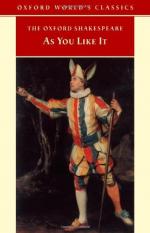|
This section contains 3,233 words (approx. 9 pages at 400 words per page) |

|
[Shaw focuses on the meaning of Rosalind's and Celia's debate over Fortune and Nature (I.ii. 40ff.), determining that this is a philosophic controversy with which Shakespeare's Elizabethan audience would have been plainly familiar. In Renaissance tradition, the goddess Fortune is depicted as the symbol of inconstancy and change. She is illustrated as either blind or blindfolded, sitting on a spherical throne with one foot either on a slippery ball or a trap and one hand placed upon a wheel. The goddess Nature, on the other hand, represents beauty, strength, nobility, courage, and-most significantly-wisdom and virtue. With open eyes, she sits firmly on a four-square pedestal, holding the mirror of Prudence that represents self-knowledge. In the classical tradition, whenever a conflict arose between Fortune and Nature, the latter, through her superior wisdom and virtuousness, would prevail. In this essay, Shaw examines how the properties of both goddesses...
|
This section contains 3,233 words (approx. 9 pages at 400 words per page) |

|




